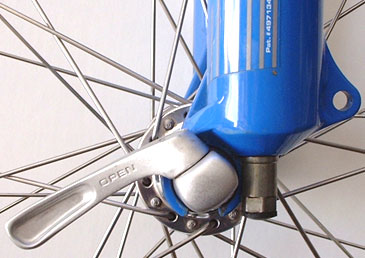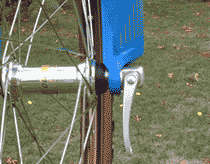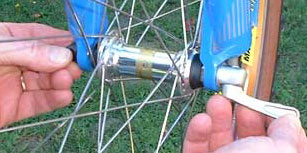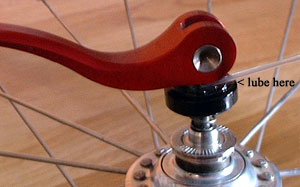How to Use Quick Release Wheels
|
Bicycle wheel quick releases make it easy to remove wheels without tools. They're a great bike feature when you're removing wheels to put a bicycle in a vehicle and if you need to repair a flat tire. You want to understand and use your wheel quick releases properly, because incorrect use is dangerous since they hold the wheels in place. The most common mistake is simply turning the lever like a nut until the wheel seems tight. Used this way the lever and wheel can loosen as you ride leading to catastrophe. The wheel can actually come loose and even fall off in a worst case. Watch this video and read the instructions below to learn how to properly use a quick release. |
Inspecting your quick release
 There are three ways to tell if the quick-release lever is doing its job to securely hold your wheel in place on your bike.
There are three ways to tell if the quick-release lever is doing its job to securely hold your wheel in place on your bike.
1) Most levers have the words "Open" and "Closed" stamped right on them, so look for that. The quick release in the photo reads "Open," meaning that the wheel is not properly fastened and it may come off–even if the wheel and lever feel tight!
2) Levers are usually curved. When the bend of the lever's curve protrudes outward like a bump, the lever is closed. When the bend is cupped (photo), the lever is open. Closing and opening the lever requires flipping it 180 degrees, not spinning it.
3) If a quick-release lever sticks out from the frame (isn't flush with it), that also means it is not fully closed. It may seem to be holding the wheel(s), however, a protruding lever is not locked shut and it's possible for it to come loose or get knocked loose if you bump it into something. Be sure to close the quick release fully if you see this to ensure your safety.
Please note, that even if the lever reads "Closed" and looks right, it's a good idea to test how tight it is by trying to open it by pulling on it with a little effort. If it resists, it's tight and safe. If it opens with only a little effort like this, it's not tight enough. Follow our directions to tighten it.
Adjusting and closing your quick release
 The repeating animation to the right shows how the quick release is closed to tighten the wheel in the fork/frame. Notice that it is flipped over on itself 180 degrees. If you do this and the quick release doesn't feel tight, or if the wheel is still loose, you need to adjust the quick release's tension.
The repeating animation to the right shows how the quick release is closed to tighten the wheel in the fork/frame. Notice that it is flipped over on itself 180 degrees. If you do this and the quick release doesn't feel tight, or if the wheel is still loose, you need to adjust the quick release's tension.
To do this, open the quick-release lever. Now, hold both ends (one on each side) and turn one clockwise until, when you close the lever 180 degrees, you feel some resistance. At this point, try to close the lever fully.
The quick-release tensioning adjustment is correct when you can fully close the lever only with some effort. A good way to do it is by pressing it closed with your palm. This lets you put your fingers behind the frame to help squeeze the lever to close it (the lever should be tight enough to leave its impression in the palm of your hand). If you can only close the lever part way, open it, unscrew the adjustment slightly and try again.
Once you have the quick-release tensioning adjustment right, make sure the wheel is fully inserted and centered in the fork (or frame) and fully close the quick release and you're ready to ride. The quick release tension adjustment won't change on its own.
Removing and installing your wheel
Most forks have wheel-retention tabs on them, which are small protrusions that keep a loose wheel from falling out of the dropouts to keep you safe in the event your wheel loosens. In order to remove and install the wheel, the quick release must be open and adjusted by unscrewing the end(s) to clear these tabs.

To do this, hold both ends of the quick release and turn one counterclockwise to unscrew it until there's enough clearance for the wheel to drop out of or fit into the fork (note that this adjustment is unnecessary on most rear wheels because rear retention tabs aren't used).
Quick-release use tips
- The quick-release levers should be on the left side of the bike.
- Quick releases must be fully closed to ensure safety.
- If you close the lever in such a way that it aligns with the fork and stays, you'll have something to grip with your fingers while squeezing the lever with your palm. It'll also keep the lever tucked away where it can't snag anything, which might happen leaning your bike next to another in a bike rack, for example.
- If you ever unscrew the quick release until it comes apart fully, don't panic! Just try not to lose the little springs. They're not crucial and the quick release will work without them. They're only there to provide spring pressure to maintain some clearance between the ends of the quick release and the axle locknuts to make it easier to slide the wheel into the frame. To reinstall the springs, make sure that the narrow ends point in.
Basic quick-release care
 About once a month, lube your quick-release levers because dry levers won't work well and can feel like they're closed and holding the wheel tight when they're not.
About once a month, lube your quick-release levers because dry levers won't work well and can feel like they're closed and holding the wheel tight when they're not.- Aluminum quick-release levers usually press against bushings as you close the lever. Lightly lube where the lever contacts the bushing (photo), to keep the quick release operating properly.
- Steel levers usually pivot inside the cap. Apply lube to trickle it inside the lever's pivot point.
- If there's a nut or screw holding the lever (look at the bottom of the cap), snug it with a wrench or screwdriver to make sure it's tight.
If you have any questions about quick release use, just let us know and we'll be happy to explain more in person.
